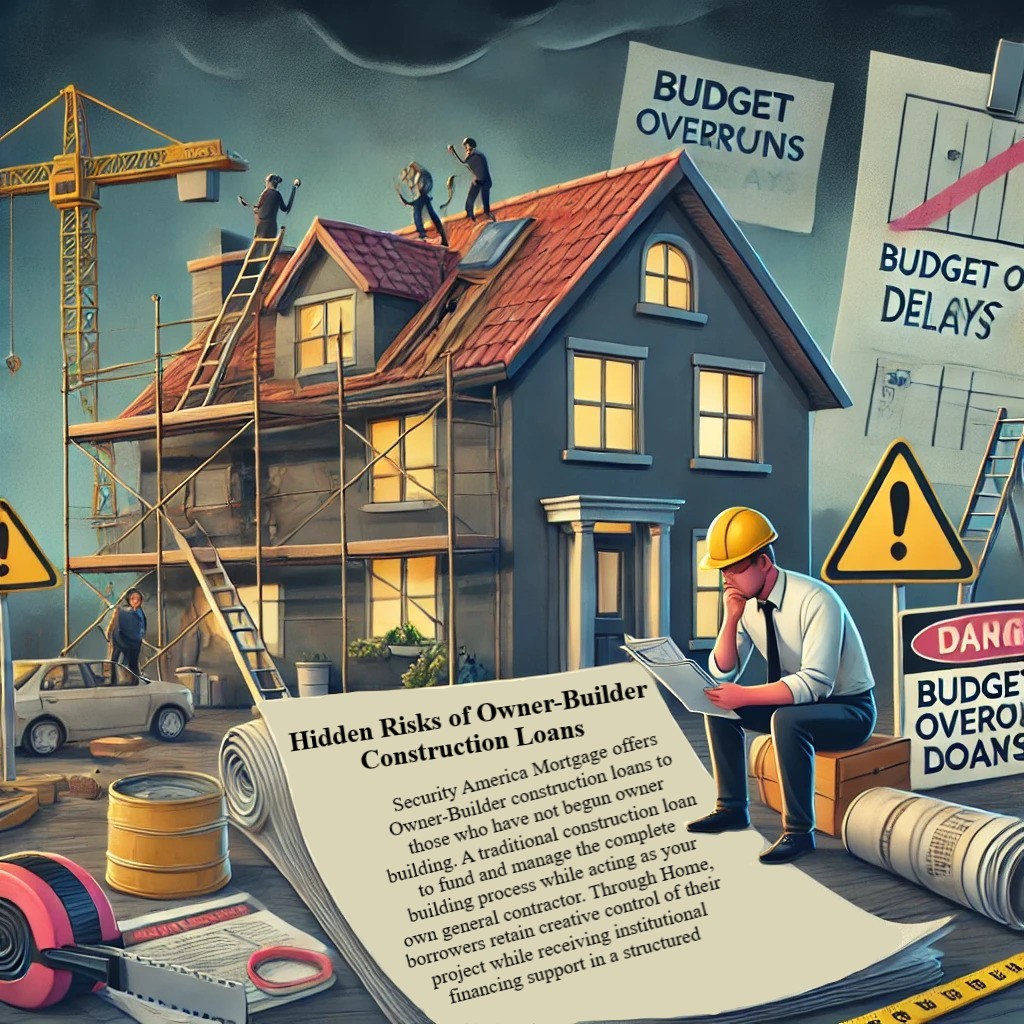
Using an owner-builder construction loan can be an effective experience in building your home and saving yourself money. These loans are not without their own challenges and, hidden risks which borrowers should bear in mind. Having an idea of these potential disasters can help you make a conscious decision and avoid expensive failures.
What Is an Owner-Builder Construction Loan?
Owner-builder construction loans sometimes called self-build loans are specialized loans that allow borrowers to fund constructing their home while also serving as their general contractor. Unlike traditional mortgages, these loans are short-term and paid out in stages (draws) during the construction process. When the home is completed, the loan either converts to a permanent mortgage or must be refinanced.
Security America Mortgage Approach
Security America Mortgage offers Owner-Builder construction loans to those who have not begun owner building. A traditional construction loan to fund and manage the complete building process while acting as your own general contractor. Through loan, borrowers retain creative control of their project while receiving institutional financing support in a structured manner.
The Hidden Risks of Owner-Builder Construction Loans
Higher Qualification Requirements
Owner-builder loans are considered high-risk by lenders, as the borrower oversees the entire construction process. That means lenders typically set high qualification standards, including:
- A higher credit score
- Down payment (usually larger, 20-25%)
- Proof of construction or homebuilding experience
- Construction plans in detail and budget approval
If you lack these factors, obtaining a loan might prove difficult, and even if you’re approved, you may be charged a higher interest rate.
Potential Construction Delays
Inexperience Managing a Construction Project Common causes include:
- Unforeseen material shortages
- Hiring unqualified subcontractors
- Weather-related setbacks
- Mismanagement of the construction schedule
Delays can also be costly, and if the project takes longer than the loan term (usually 12-24 months), you might need to request an extension or seek refinancing, which may incur more fees.
Financial Strain and Budget Overruns
Overruns are a common problem with owner-builder loans. Unforeseen expenses including but not limited to increased labor costs, permit fees and construction material price changes can put a strain on your budget. Because lenders disburse funds in phases, according to bankable milestones met in the project, any overage costs would have to come directly out of pocket, potentially resulting in financial strain.
Loan Draw Complications
Unlike conventional home loans that give a lump sum, owner-builder loans release funds in stages (draws) dependent on the completion of work. This means:
- Constriction time line is a hard line you have to follow
- Even release of funds is only permitted on inspections
- Delays in the inspections or approvals can hold back the project
If you don’t have enough personal capital to cover interim costs, the projects can still waiting for the next draw approval.
Lack of Professional Oversight
If you act as your own general contractor, you assume the roles of professionals that may include:
- Hiring and Running Subcontractors
- Getting permits and inspections
- Making sure that work meets quality standards and building codes
You may not be able to handle these tasks efficiently without professional experience, which may result in expensive mistakes or legal consequences.
Risks Related to Property Appraisal and the Market
After construction is finished, the value of your home will be assessed. If market conditions change or the home’s final value is less than anticipated, it could be difficult to obtain a permanent mortgage or refinance the loan. This may result in financing shortfall or additional money in need to bridge the gap.
Mitigating the Risks
Owner-builder construction loans do come with their own risks and challenges, but they can be managed with the following best practices:
- Partner with experienced professionals: Hiring a construction manager or consultant can bring valuable expertise.
- Contingency fund: Allocate additional 10-20% of budget for unforeseen expenses.
- Select a single-close construction-to-permanent loan: This one-cut option limits the risk of requiring a second closing and streamlines financing.
- Learn lender requirements: Make sure you qualify for all requirements before applying, and you have a strong game plan for constructing.
Conclusion
Owner-builder construction loans provide the freedom to build your perfect home whilst it is also likely to save you money this freedom does, however, come with high stakes. You will also learn about the challenges like bonding requirements and qualification criteria, budget overages, construction delays and loan draw complexities that you need to understand in order to prepare for a successful self-build.
For those who have yet to start construction on their own, Security America Mortgage offers self-build loans, which will give you a structured financing solution to support your project. If you’re thinking about an owner-builder loan, partnering with a qualified lender and forming a detailed plan can help you mitigate the risks and make your dream a reality.
